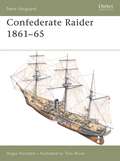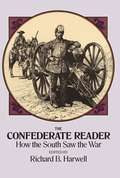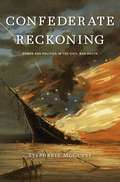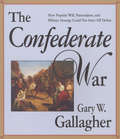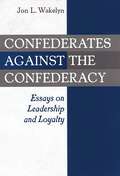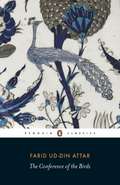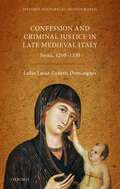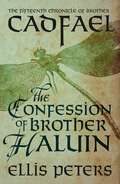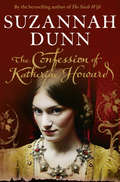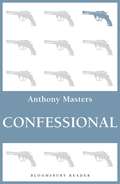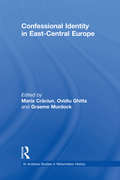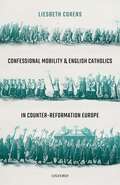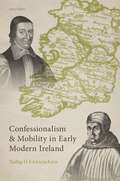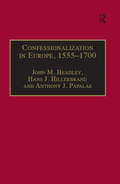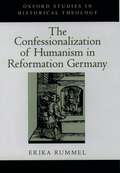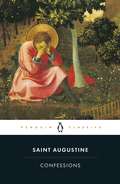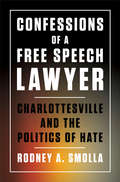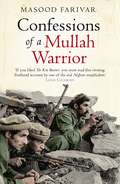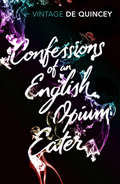- Table View
- List View
Confederate Raider 1861–65 (New Vanguard)
by Angus KonstamThe Confederate states adopted radical solutions to counter the naval superiority of their opponents. One of the more successful solutions they adopted was the use of commerce raiders. This book describes the reasons which forced the Confederates to resort to commerce raiding, and outlines the way in which these craft were converted or specially built to perform their role. It details not only the way these craft were operated and manned, but also their brutal attacks, daring escapes and climatic battles against the large numbers of Union warships forced to hunt them down.
The Confederate Reader: How the South Saw the War (Civil War Ser.)
by Richard B. HarwellFor any student of the War Between the States, this treasury of contemporary documents—all but a few written by Southerners — offers a wealth of insight and perspectives on life in the South during the conflict, how newspapers and periodicals covered events, and how Southerners reacted to the disastrous struggle that disrupted their lives and ravaged their homes, farms, and cities. Selections have been arranged in an order that demonstrates the progress of the war, beginning with a South Carolina ordinance to secede from the Union and ending with a final message in 1865 from the last Confederate general to surrender. Relive the day-to-day reality of the War as captured in a rich legacy of written records: official battle reports, general orders, letters, sermons, songs, published articles, novels, and accounts of travel, prison, and conditions of army life. Included are contemporary newspaper accounts of the Battle of Fort Sumter, a stirring address to his soldiers by Jefferson Davis in 1864, a Confederate prisoner's account of life in a Yankee prison, a newspaper report of the sack and destruction of Columbia, South Carolina, a poignant last-ditch attempt by General E. Kirby Smith in 1865 to rally the Trans-Mississippi Army, and many more. A selection of authentic cartoons, sketches, and broadsides from various periods of the War adds a special "you-are-there" flavor to the book. Carefully chosen and annotated by a distinguished authority on the Confederacy, these selections paint a broad and moving picture of the attitudes, emotions, and ideas that motivated and sustained the South during the War. Assembled in this inexpensive paperback edition of The Confederate Reader, they will bring new insight and enlightenment to any Civil War buff or student of American history.
Confederate Reckoning: Power and Politics in the Civil War South
by Stephanie McCurryPulitzer Prize Finalist Winner of the Frederick Douglass Prize Winner of the Merle Curti Prize “Perhaps the highest praise one can offer McCurry’s work is to say that once we look through her eyes, it will become almost impossible to believe that we ever saw or thought otherwise.”—Drew Gilpin Faust, The New Republic The story of the Confederate States of America, the proslavery, antidemocratic nation created by white Southern slaveholders to protect their property, has been told many times in heroic and martial narratives. Now, however, Stephanie McCurry tells a very different tale of the Confederate experience. When the grandiosity of Southerners’ national ambitions met the harsh realities of wartime crises, unintended consequences ensued. Although Southern statesmen and generals had built the most powerful slave regime in the Western world, they had excluded the majority of their own people—white women and slaves—and thereby sowed the seeds of their demise. Wartime scarcity of food, labor, and soldiers tested the Confederate vision at every point and created domestic crises to match those found on the battlefields. Women and slaves became critical political actors as they contested government enlistment and tax and welfare policies, and struggled for their freedom. The attempt to repress a majority of its own population backfired on the Confederate States of America as the disenfranchised demanded to be counted and considered in the great struggle over slavery, emancipation, democracy, and nationhood. That Confederate struggle played out in a highly charged international arena. The political project of the Confederacy was tried by its own people and failed. The government was forced to become accountable to women and slaves, provoking an astounding transformation of the slaveholders’ state. Confederate Reckoning is the startling story of this epic political battle in which women and slaves helped to decide the fate of the Confederacy and the outcome of the Civil War.
The Confederate War
by Gary W. GallagherIf one is to believe contemporary historians, the South never had a chance. Many allege that the Confederacy lost the Civil War because of internal division or civilian disaffection; others point to flawed military strategy or ambivalence over slavery. But, argues distinguished historian Gary Gallagher, we should not ask why the Confederacy collapsed so soon but rather how it lasted so long. In The Confederate War he reexamines the Confederate experience through the actions and words of the people who lived it to show how the home front responded to the war, endured great hardships, and assembled armies that fought with tremendous spirit and determination. Gallagher’s portrait highlights a powerful sense of Confederate patriotism and unity in the face of a determined adversary. Drawing on letters, diaries, and newspapers of the day, he shows that Southerners held not only an unflagging belief in their way of life, which sustained them to the bitter end, but also a widespread expectation of victory and a strong popular will closely attuned to military events. In fact, the army’s “offensive-defensive” strategy came remarkably close to triumph, claims Gallagher—in contrast to the many historians who believe that a more purely defensive strategy or a guerrilla resistance could have won the war for the South. To understand why the South lost, Gallagher says we need look no further than the war itself: after a long struggle that brought enormous loss of life and property, Southerners finally realized that they had been beaten on the battlefield. Gallagher’s interpretation of the Confederates and their cause boldly challenges current historical thinking and invites readers to reconsider their own conceptions of the American Civil War.
Confederates against the Confederacy: Essays on Leadership and Loyalty
by Jon L. WakelynFar from being a monolith with unanimous leadership loyalty to the cause of a separate nation, the Confederacy was in reality deeply divided over how to achieve independence. Many supposedly loyal leaders, civilian as well as elected officials, opposed governmental policies on the national and state levels, and their actions ultimately influenced non-support for military policies. Congressional differences over arming the slaves and bureaucratic squabbles over how to conduct the war disrupted the government and Cabinet of President Jefferson Davis. Rumors of such irreconcilable differences spread throughout the South, contributing to an overall decline in morale and support for the war effort and causing the Confederacy to come apart from within.When asked to make sacrifices, civilian leaders found themselves caught in the dilemma of either aiding the Confederacy or losing money through poor utilization of slave labor. To sustain profits, the business and planter classes often traded with the enemy. Upon consideration of arming the slaves, many members of Congress proclaimed that the war effort was not worth the demise of slavery and preferred instead to take their chances with the Northern government. Cultural leaders, clergy, newspapermen, and men of letters claimed their loyalty to the war effort, but often criticized government policies in public. By asking for financial support and instituting a military draft, the national government infuriated local patriots who wanted to defend their own states more than they desired to defeat the enemy.
The Conference of the Birds: The Selected Sufi Poetry Of Farid Ud-din Attar (Ways Of Mysticism Ser. #Vol. 1)
by Farid AttarComposed in the twelfth century in north-eastern Iran, Attar's great mystical poem is among the most significant of all works of Persian literature. A marvellous, allegorical rendering of the Islamic doctrine of Sufism - an esoteric system concerned with the search for truth through God - it describes the consequences of the conference of the birds of the world when they meet to begin the search for their ideal king, the Simorgh bird. On hearing that to find him they must undertake an arduous journey, the birds soon express their reservations to their leader, the hoopoe. With eloquence and insight, however, the hoopoe calms their fears, using a series of riddling parables to provide guidance in the search for spiritual truth. By turns witty and profound, The Conference of the Birds transforms deep belief into magnificent poetry.
Confession and Criminal Justice in Late Medieval Italy: Siena, 1260-1330 (Oxford Historical Monographs)
by Lidia Luisa Zanetti DominguesIn medieval Italy the practice of revenge as criminal justice was still popular amongst members of all social classes, yet crime also was increasingly perceived as a public matter that needed to be dealt with by the government rather than private citizens. Confession and Criminal Justice in Late Medieval Italy sheds light on this contradiction through an in-depth comparison of lay and religious sources produced in Siena between 1260 and 1330 on criminal justice, conflict, and violence. Confession and Criminal Justice in Late Medieval Italy: argues that religious people were an effective pressure group with regards to criminal justice, thanks both to the literary works they produced and their direct intervention in political affairs, and that their contributions have not received the attention they deserve. It shows that the dichotomy between theories and practices of 'private' and of 'public' justice should be substituted by a framework in which three models, or discourses, of criminal justice are recognised as present in medieval Italian communes, with the addition of a specifically religious discourse based on penitential spirituality. Although the models of criminal justice were competing, they also influenced each other.
Confession and Criminal Justice in Late Medieval Italy: Siena, 1260-1330 (Oxford Historical Monographs)
by Lidia Luisa Zanetti DominguesIn medieval Italy the practice of revenge as criminal justice was still popular amongst members of all social classes, yet crime also was increasingly perceived as a public matter that needed to be dealt with by the government rather than private citizens. Confession and Criminal Justice in Late Medieval Italy sheds light on this contradiction through an in-depth comparison of lay and religious sources produced in Siena between 1260 and 1330 on criminal justice, conflict, and violence. Confession and Criminal Justice in Late Medieval Italy: argues that religious people were an effective pressure group with regards to criminal justice, thanks both to the literary works they produced and their direct intervention in political affairs, and that their contributions have not received the attention they deserve. It shows that the dichotomy between theories and practices of 'private' and of 'public' justice should be substituted by a framework in which three models, or discourses, of criminal justice are recognised as present in medieval Italian communes, with the addition of a specifically religious discourse based on penitential spirituality. Although the models of criminal justice were competing, they also influenced each other.
The Confession Of Brother Haluin (The Cadfael Chronicles #15)
by Ellis PetersDecember, 1142. A brother of Shrewsbury Abbey suffers a fall that almost kills him. He makes a shocking deathbed confession to Brother Cadfael. When the man recovers Cadfael accompanies him on an arduous journey to redeem his past sins.
The Confession of Katherine Howard
by Suzannah DunnThe new novel from the bestselling author of THE SIXTH WIFE.
Confessional
by Anthony MastersThe extraordinary, demonic monument to Franco broods over the Valley of the Fallen, north of Madrid. Here, in the hallowed seclusion of the confessional box, Eduardo Tomas, Spain's Home Affairs Minister, is gunned down by a manipulative killer. Senior Interpol officer, Marius Larche, heads the investigating team; his number two, Detective Superintendent Alison Rowe, seconded from Scotland Yard because of her special knowledge of one particular political assassin, suspected of the murder. On the beautiful fortress-like island of Molino, they investigate the web of secrecy and suspicion which surrounds the Minister's widow and the whole Tomas family. As Larche and Rowe assemble their suspects in the lavish retreat overlooking the Mediterranean, a ruthless killer penetrates the rigid security ... Political and religious intrigue, the hedonism of the rich and the brutality of desperate people make an irresistible melange in Confessional, first published in 1993, a successor to Anthony Masters' first Marius Larche investigation, Murder is a Long Time Coming.
Confessional Identity in East-Central Europe (St Andrews Studies in Reformation History)
by Maria Craciun Ovidiu GhittaThis book considers the emergence of a remarkable diversity of churches in east-central Europe between the 16th and 18th centuries, which included Catholic, Orthodox, Hussite, Lutheran, Bohemian Brethren, Calvinist, anti-Trinitarian and Greek Catholic communities. Contributors assess the extraordinary multiplicity of confessions in the Transylvanian principality, as well as the range of churches in Poland, Bohemia, Moravia and Hungary. Essays focus on how each church sought to establish its own identity in a crowded market-place of religious ideas, and on the extent to which printed literature brokered the popular reception of religious doctrine. The volume addresses how ideas about religion spread within the largely illiterate societies of east-central Europe, especially through catechisms, and how printed literature was used to instruct congregations about doctrinal truth, to encourage the faithful to pious devotions, and to shape the religious life and identity of local communities.
Confessional Identity in East-Central Europe (St Andrews Studies in Reformation History)
by Maria Craciun Ovidiu GhittaThis book considers the emergence of a remarkable diversity of churches in east-central Europe between the 16th and 18th centuries, which included Catholic, Orthodox, Hussite, Lutheran, Bohemian Brethren, Calvinist, anti-Trinitarian and Greek Catholic communities. Contributors assess the extraordinary multiplicity of confessions in the Transylvanian principality, as well as the range of churches in Poland, Bohemia, Moravia and Hungary. Essays focus on how each church sought to establish its own identity in a crowded market-place of religious ideas, and on the extent to which printed literature brokered the popular reception of religious doctrine. The volume addresses how ideas about religion spread within the largely illiterate societies of east-central Europe, especially through catechisms, and how printed literature was used to instruct congregations about doctrinal truth, to encourage the faithful to pious devotions, and to shape the religious life and identity of local communities.
Confessional Mobility and English Catholics in Counter-Reformation Europe
by Liesbeth CorensIn the wake of England's break with Rome and gradual reformation, English Catholics took root outside of the country, in Catholic countries across Europe. Their arrival and the foundation of convents and colleges on the Continent as attracted scholarly attention. However, we need to understand their impact beyond that initial moment of change. Confessional Mobility, therefore, looks at the continued presence of English Catholics abroad and how the English Catholic community was shaped by these cross-Channel connections. Corens proposes a new interpretative model of 'confessional mobility'. She opens up the debate to include pilgrims, grand tour travellers, students, and mobile scholars alongside exiles. The diversity of mobility highlights that those abroad were never cut off or isolated on the Continent. Rather, through correspondence and constant travel, they created a community without borders. This cross-Channel community was not defined by its status as victims of persecution, but provided the lifeblood for English Catholics for generations. Confessional Mobility also incorporates minority Catholics more closely into the history of the Counter-Reformation. Long side-lined as exceptions to the rule of a hierarchical, triumphant, territorial Catholic Church, English Catholic have seldom been recognised as an instrumental part in the wider Counter-Reformation. Attention to movement and mission in the understanding of Catholics incorporates minority Catholics alongside extra-European missions and reinforces current moves to decentre Counter-Reformation scholarship.
Confessional Mobility and English Catholics in Counter-Reformation Europe
by Liesbeth CorensIn the wake of England's break with Rome and gradual reformation, English Catholics took root outside of the country, in Catholic countries across Europe. Their arrival and the foundation of convents and colleges on the Continent as attracted scholarly attention. However, we need to understand their impact beyond that initial moment of change. Confessional Mobility, therefore, looks at the continued presence of English Catholics abroad and how the English Catholic community was shaped by these cross-Channel connections. Corens proposes a new interpretative model of 'confessional mobility'. She opens up the debate to include pilgrims, grand tour travellers, students, and mobile scholars alongside exiles. The diversity of mobility highlights that those abroad were never cut off or isolated on the Continent. Rather, through correspondence and constant travel, they created a community without borders. This cross-Channel community was not defined by its status as victims of persecution, but provided the lifeblood for English Catholics for generations. Confessional Mobility also incorporates minority Catholics more closely into the history of the Counter-Reformation. Long side-lined as exceptions to the rule of a hierarchical, triumphant, territorial Catholic Church, English Catholic have seldom been recognised as an instrumental part in the wider Counter-Reformation. Attention to movement and mission in the understanding of Catholics incorporates minority Catholics alongside extra-European missions and reinforces current moves to decentre Counter-Reformation scholarship.
Confessionalism and Mobility in Early Modern Ireland
by Tadhg Ó hAnnracháinThe period between c.1580 and c.1685 was one of momentous importance in terms of the establishment of different confessional identities in Ireland, as well as a time of significant migration and displacement of population. Confessionalism and Mobility in Early Modern Ireland provides an entirely new perspective on religious change in early modern Ireland by tracing the constant and ubiquitous impact of mobility on the development and maintenance of the island's competing confessional groupings. Confessionalism and Mobility in Early Modern Ireland examines the dialectic between migration and religious adherence, paying particular attention to the pronounced transnational dimension of clerical formation which played a vital role in shaping the competing Catholic, Church of Ireland, and non-conformist clergies. It demonstrates that the religious transformation of the island was mediated by individuals with very significant migratory experiences and the importance of religion in enabling individuals to negotiate the challenges and opportunities created by displacement and settlement in new environments. The volume investigates how more quotidian practices of mobility such as pilgrimage and inter-parochial communions helped to elaborate religious identities and analyses the extraordinary importance of migratory experience in shaping the lives and writings of the authors of key confessional identity texts. Confessionalism and Mobility in Early Modern Ireland demonstrates that Irish society was enormously influenced by migratory experiences and argues that a case study of the island also has important implications for understanding religious change in other areas of Europe and the rest of the world.
Confessionalism and Mobility in Early Modern Ireland
by Tadhg Ó hAnnracháinThe period between c.1580 and c.1685 was one of momentous importance in terms of the establishment of different confessional identities in Ireland, as well as a time of significant migration and displacement of population. Confessionalism and Mobility in Early Modern Ireland provides an entirely new perspective on religious change in early modern Ireland by tracing the constant and ubiquitous impact of mobility on the development and maintenance of the island's competing confessional groupings. Confessionalism and Mobility in Early Modern Ireland examines the dialectic between migration and religious adherence, paying particular attention to the pronounced transnational dimension of clerical formation which played a vital role in shaping the competing Catholic, Church of Ireland, and non-conformist clergies. It demonstrates that the religious transformation of the island was mediated by individuals with very significant migratory experiences and the importance of religion in enabling individuals to negotiate the challenges and opportunities created by displacement and settlement in new environments. The volume investigates how more quotidian practices of mobility such as pilgrimage and inter-parochial communions helped to elaborate religious identities and analyses the extraordinary importance of migratory experience in shaping the lives and writings of the authors of key confessional identity texts. Confessionalism and Mobility in Early Modern Ireland demonstrates that Irish society was enormously influenced by migratory experiences and argues that a case study of the island also has important implications for understanding religious change in other areas of Europe and the rest of the world.
Confessionalization in Europe, 1555–1700: Essays in Honor and Memory of Bodo Nischan
by John M. Headley Hans J. HillerbrandConfessionalization in Europe, 1555-1700 brings together a closely-focused set of essays by leading scholars from the USA, UK, and Europe, in memory of Bodo Nischan. They address what historians of the Early Modern period have recently come to define as the pre-eminent issue in the history of the Reformation, as they turn their emphases from the earlier part of the 16th century to the relatively neglected latter half of the century. By the time of his death Bodo Nischan had distinguished himself as a significant contributor to this central problem of confessionalization. The concept involves the practice of 'confession building' which in relation to that of 'social disciplining', promoted interrelated processes contributing decisively to the formation of confessional churches, greater social cohesion, and the emergence of the Early Modern absolute state. Many religious practices, earlier considered as adiaphora (indifferent matters), now became treated as marks of demarcation between the emerging Protestant confessional churches and at the same time politicized as the early modern state sought to impose greater social control. Through the analysis of such liturgical, ritual, and ceremonial practices Nischan helped show the way towards a better understanding of the Reformation's engagement with the people. These are the themes treated in this volume.
Confessionalization in Europe, 1555–1700: Essays in Honor and Memory of Bodo Nischan
by John M. Headley Hans J. HillerbrandConfessionalization in Europe, 1555-1700 brings together a closely-focused set of essays by leading scholars from the USA, UK, and Europe, in memory of Bodo Nischan. They address what historians of the Early Modern period have recently come to define as the pre-eminent issue in the history of the Reformation, as they turn their emphases from the earlier part of the 16th century to the relatively neglected latter half of the century. By the time of his death Bodo Nischan had distinguished himself as a significant contributor to this central problem of confessionalization. The concept involves the practice of 'confession building' which in relation to that of 'social disciplining', promoted interrelated processes contributing decisively to the formation of confessional churches, greater social cohesion, and the emergence of the Early Modern absolute state. Many religious practices, earlier considered as adiaphora (indifferent matters), now became treated as marks of demarcation between the emerging Protestant confessional churches and at the same time politicized as the early modern state sought to impose greater social control. Through the analysis of such liturgical, ritual, and ceremonial practices Nischan helped show the way towards a better understanding of the Reformation's engagement with the people. These are the themes treated in this volume.
The Confessionalization of Humanism in Reformation Germany (Oxford Studies in Historical Theology)
by Erika RummelThis book deals with the impact of the Reformation debate in Germany on the most prominent intellectual movement of the time: humanism. Although it is true that humanism influenced the course of the Reformation, says Erika Rummel, the dynamics of the relationship are better described by saying that humanism was co-opted, perhaps even exploited, in the religious debate.
Confessions
by Saint Augustine R. Pine-CoffinThe son of a pagan father and a Christian mother, Saint Augustine spent his early years torn between conflicting faiths and world views. His Confessions, written when he was in his forties, recount how, slowly and painfully, he came to turn away from his youthful ideas and licentious lifestyle, to become instead a staunch advocate of Christianity and one of its most influential thinkers. A remarkably honest and revealing spiritual autobiography, the Confessions also address fundamental issues of Christian doctrine, and many of the prayers and meditations it includes are still an integral part of the practice of Christianity today.
Confessions of a Free Speech Lawyer: Charlottesville and the Politics of Hate
by Rodney A. SmollaIn the personal and frank Confessions of a Free Speech Lawyer, Rodney A. Smolla offers an insider's view on the violent confrontations in Charlottesville during the "summer of hate." Blending memoir, courtroom drama, and a consideration of the unhealed wound of racism in our society, he shines a light on the conflict between the value of free speech and the protection of civil rights.Smolla has spent his career in the thick of these tempestuous and fraught issues, from acting as lead counsel in a famous Supreme Court decision challenging Virginia's law against burning crosses, to serving as co-counsel in a libel suit brought by a fraternity against Rolling Stone magazine for publishing an article alleging that one of the fraternity's initiation rituals included gang rape. Smolla has also been active as a university leader, serving as dean of three law schools and president of one and railing against hate speech and sexual assault on US campuses.Well before the tiki torches cast their ominous shadows across the nation, the city of Charlottesville sought to relocate the Unite the Right rally; Smolla was approached to represent the alt-right groups. Though he declined, he came to wonder what his history of advocacy had wrought. Feeling unsettlingly complicit, he joined the Charlottesville Task Force, and he realized that the events that transpired there had meaning and resonance far beyond a singular time and place. Why, he wonders, has one of our foundational rights created a land in which such tragic clashes happen all too frequently?
Confessions of a Mullah Warrior
by Masood FarivarMasood Farivar was ten years old when his childhood in a then peaceful and prosperous Afghanistan was shattered by the Soviet invasion of 1979. Fleeing across the border to Pakistan, Masood entered a madrassa for refugees, but soon returned to his home to join the anti-Soviet jihad. Two years later, having fought alongside the Afghan mujahideen and Arab and Pakistani volunteers, Farivar left his country to study at Harvard, and then worked as a journalist in New York. But finally, after a decade in the United States, he felt he had to return to Afghanistan. Having seen terrorism turn America into a hotbed of anti-Muslim racism, he now returned to a country devastated by war and a safe haven for international terrorists. In this remarkable memoir, Masood paints a vibrant portrait of his family and his nation's history, reveals the world of militant Islam by taking us deep inside the madrassas, vividly recounts his experiences on the battlefield at Tora Bora, and conveys the culture shock of a Muslim living in the West today.
Confessions of an English Opium-Eater: Being An Extract From The Life Of A Scholar; From The Last London Edition...
by Thomas De Quincey Howard MarksWITH AN INTRODUCTION BY HOWARD MARKSOnce upon a time, opium (the main ingredient of heroin) was easily available over the chemist's counter. The secret of happiness, about which philosophers have disputed for so many ages, could be bought for a penny, and carried in the waistcoat pocket: portable ecstasies could be corked up in a pint bottle. Paradise? So thought Thomas de Quincey, but he soon discovered that 'nobody will laugh long who deals much with opium'.
Confessions of an Improper Bride (A Donovan Novel #1)
by Jennifer HaymoreTWICE TEMPTED Serena Donovan left London six years ago, her heart broken and her reputation ruined by devilishly handsome Jonathan Dane. Now, with her family's future in peril, she reluctantly agrees to return to England and assume her late twin's identity. The price? Marry a man she doesn't love and spend the rest of her days living a lie. Jonathan Dane, Earl of Stratford, has become an incorrigible rake, drinking, gambling-and trying to forget Serena Donovan. Yet the moment he's introduced to the prim and proper "Meg", he recognizes the sensual young woman who captured his heart. Haunted by his past mistakes, he refuses to lose Serena again. But convincing her to trust him is no easy task. Claiming his lost love means exposing the truth and destroying the life Serena has sacrificed everything to rebuild. With the future of all the Donovans at stake, and their undying passion capable of triggering yet another scandal, how much will Jonathan and Serena risk for a chance at true love?
